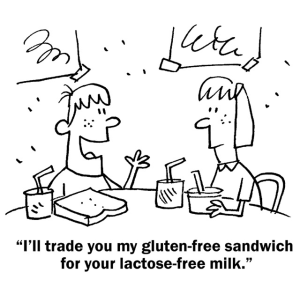For as long as I can remember, I’ve been sick. I was described as a sickly kid, who grew into a sickly adult. I was told I was the most likely person to contract food poisoning (7 times in my young life) and no one wanted to share food with me from September through May for fear of catching whatever cold was on my horizon. So I thought that my destiny was just to feel like crap most of the time, and I had made peace with it right around the time I discovered the word gluten.
I remember the first time I heard the word gluten.
Why am I hearing it everywhere lately? And what is it? I was about to find out that it’s a protein derived from wheat, barley and rye, and it’s in virtually everything. Everything.
After being diagnosed with Non Celiac Gluten Sensitivity in 2009, I cut out gluten. I now live a life free of aches, pains, sickness, discomfort, headaches and emotional turmoil. Yay for not feeling crazy anymore!
It wasn’t IBS, PMS or any other acronym I was labeled over the years; it was simply a food intolerance that had plagued me my while life.
And it turns out I’m a part of a fast growing community of people who are realizing they have either a full-blown allergy to gluten (Celiac Disease) or suffer from Non-Celiac Gluten Sensitivity (NCGS), which is currently a little more difficult to pinpoint. People who suffer from NCGS experience very similar reactions to gluten as people with Celiac Disease, but the blood test which identifies and diagnoses celiac disease returns negative in their case.
Celiac disease, also known as gluten intolerance, is a genetic disorder that affects at least 1 in 133 Americans. Symptoms of celiac disease can range from the classic ones, such as diarrhea, weight loss, and malnutrition, to latent symptoms such as isolated nutrient deficiencies but no gastrointestinal symptoms.
Recent research and current gluten intolerance statistics suggest that 5% to 10% of the population may suffer from some form of gluten intolerance, and yet a vast majority of these individuals have not yet been properly diagnosed.
Some practitioners theorize that celiac disease may be triggered after infection by a type of virus that biologically resembles the proteins in gluten. After the infection, the body can’t distinguish between the virus and the gluten protein, and subsequently, the body reacts allergically, releasing mucous into the intestinal tract upon gluten exposure, causing damage to the intestines.
In addition to viral infections, celiac disease is also known to be triggered in susceptible people by pregnancy, severe stress, or physical trauma.
So what is Gluten anyway?
Gluten is the protein found in wheat, rye, barley, durum, einkorn, graham, semolina, bulgur wheat, spelt, farro, kamut, and triticale. Commercial oats may also contain gluten due to cross contamination in processing, and so are often eliminated from gluten-free diets as well.
My go-to guide for questions related to Celiac Disease or sensitivities is Celiac.com. It’s a great resource powered by doctors, nutritionists and other well versed authors who post often and are quick to reply to questions on their comment boards and via twitter and facebook pages. I highly recommend following their posts and exploring their Gluten Free Mall for those of you who don’t have as much access to gluten free products as you would like.
How do I make the change and go Gluten-free?

For many of us, the idea of eliminating all gluten from our diets is scary, overwhelming and just plain awful to imagine. I remember when I was diagnosed with NCGS; I thought about my great-grandmother’s homemade pasta, my grandmother’s many italian dishes, my love of piping hot bread, crispy on the outside, warm and gooey on the inside…. I couldn’t imagine a life without bread, pizza, pasta, pastries and I figured it just wasn’t going to be worth it. But, I decided I could give anything a shot once, and if I truly felt better once I cut gluten from my diet, then surely I could find a way to do without.
It turns out I had an absolute (and quite common, it turns out) relationship with food. I didn’t realize at the time, but my initial response was one of mourning; mourning the loss of gluten in my diet. Sounds crazy, right? It was such a powerful response that I had to admit later that I had a very real addiction to food.
The key point I took away from this was that I needed to reprogram my way of thinking as it related to food. I had to learn that there were still many delicious foods to discover, and realize that I wasnt deriving true happiness or satisfaction from food. In fact, what I’ve learned is that truly whole, healthy foods are more satisfying than the chocolate chip cookies I used to love. For real.
So, I grew to think of it as a phyiscal and mental reboot. Similar to rebooting your computer, I realized I needed to recharge my own internal battery. And so I started my gluten free life and I’ve never felt better.
Browse some helpful links below for recipes, inspiration, supportive tips and more:
Celiac disease vs. Gluten-sensitivity
Welcome to Gluten-freedom!
Comments Closed